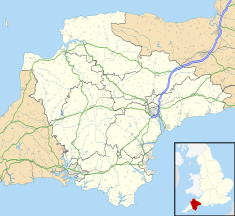Devonport Guildhall
| Devonport Guildhall | |
|---|---|
 Devonport Guildhall pictured in 2012 | |
| Location | Devonport, Plymouth, Devon, England |
| Coordinates | 50°22′08″N 4°10′34″W / 50.3689°N 4.1762°W |
| Built | 1821–1824 |
| Original use | Town hall, courthouse, mortuary, police station |
| Architect | John Foulston |
| Architectural style(s) | Regency style |
Listed Building – Grade I | |
| Official name | Devonport Guildhall and Attached Walls |
| Type | Listed Building |
| Designated | 25 January 1954 |
| Reference no. | 1322009 |
Devonport Guildhall is a municipal building that served as a municipal hall, courthouse, mortuary, and police station, located in the municipal centre of the town of Devonport, in Plymouth, Devon, England. The site fell into disrepair and since the mid-1980s has been repurposed for community facilities.[1] It is a Grade I listed building.[2]
History
[edit]The building of the guildhall
[edit]
The guildhall, which was designed by John Foulston in the Regency style with Greek Doric features, was completed between 1821 and 1824.[2] Foulston designed a cluster of four buildings together in the area: the Guildhall, Column and Oddfellow's Hall still stand today whilst his Mount Zion Calvinist Chapel is now lost.[3] The area of Devonport was then called Plymouth Dock and the presence of the Royal Navy brought prosperity to the area. A petition was taken to King George IV, who granted permission for the area to be called Devonport in 1824.[4]
Devonport Guildhall was home to the magistrates court and the Mayor's Parlour and also was used for social events (the courtroom had removable fixtures to hold events and balls in the evening). There were cells and a mortuary, and a police station at the rear of the building.[1] It was also the meeting place of the county borough of Devonport established under the Local Government Act 1888.[5]
Decline and refurbishment
[edit]The building fell into disrepair when the Three Towns of Plymouth, Devonport and Stonehouse amalgamated in 1914[6] and municipal functions were transferred to the expanded City of Plymouth.[1] Still utilised for the city, the building had a variety of uses, including as a gas-mask collection point during the Second World War. After it fell into neglect, Guildhall restorations were attempted – notably in 1986 when it reopened as a Citizen's Advice Bureau, Library, a playgroup, cafe and sports hall – but failed to survive due to the sheer size of the building. In 2009, Real Ideas Organisation was awarded a £1.75 million Community Assets Grant, with which they embarked on the careful and painstaking restoration of Devonport Guildhall to its former glory. Working closely with Plymouth City Council and the former Devonport Regeneration Community Partnership, RIO renovated Devonport Guildhall with the local community in mind.[1][7][8] The building, which is run by a social enterprise, re-opened in 2010.[9][10][11]
See also
[edit]References
[edit]- ^ a b c d "About". Devonport Guildhall. Retrieved 12 April 2015.
- ^ a b Historic England. "Devonport Guildhall and Attached Walls (Grade I) (1322009)". National Heritage List for England. Retrieved 7 March 2019.
- ^ "Mount Zion Calvinist Chapel, Ker Street, Devonport, Plymouth: elevation and detail". Royal Institute of British Architects. Retrieved 18 August 2020.
- ^ "Plymouth Dock Renamed Devonport". Vicroia and Albert Museum. Retrieved 26 August 2019.
- ^ "Local Government Act 1888". Legislation.gov.uk. Retrieved 18 August 2020.
- ^ "The early history of Plymouth". Archived from the original on 9 June 2008. Retrieved 19 July 2008.
- ^ "Devonport Guildhall reopens after £1.75m makeover". Plymouth Herald. Archived from the original on 24 September 2015. Retrieved 12 April 2015.
- ^ "Delivering Change: Devonport". Plymouth Council. Retrieved 12 April 2015.
- ^ "Devonport Guildhall". Le Page Architects. Retrieved 12 April 2015.
- ^ "Devonport Guildhall". Archived from the original on 29 November 2014. Retrieved 12 April 2015. retrieved 12 April 2015
- ^ "In pictures: Gilding Plymouth's Devonport Guildhall". BBC. Retrieved 12 April 2015.
Further reading
[edit]- Jenkins, Frank (1968). "John Foulston and His Public Buildings in Plymouth, Stonehouse, and Devonport". Journal of the Society of Architectural Historians (University of California Press) 27 (2): 124–135. doi:10.2307/988470. Retrieved 18 December 2012. – via JSTOR (subscription required)

